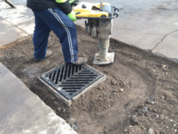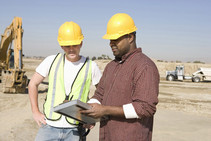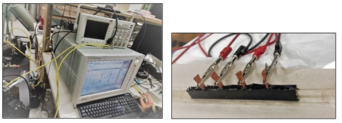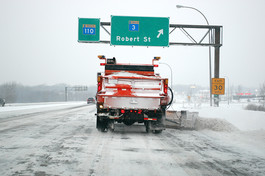
MAINTENANCE OPERATIONS — This Local Road Research Board project updated information about manhole and catch basin installation and maintenance. Municipal engineers shared their current practices, product preferences and specifications for these facilities. The resulting report includes current information about construction practices, products to seal joints and surfaces against water infiltration, and effective methods to backfill and compact soil around new installations to prevent the soil from settling and heaving.
Report 2021RIC04
|

Local transportation agencies in Minnesota are facing a growing workforce shortage. The LRRB recently sponsored a project to help expand the transportation workforce and fill open positions—today and tomorrow.
The ‘Expanding the Transportation Workforce’ project, led by Minnesota LTAP, created two sets of tools: One set helps local agencies attract and retain workers in the short term, while another set helps agencies promote career opportunities to students and feed the longer-term worker pipeline.
The project was guided by a technical advisory panel of experienced transportation professionals representing local agencies and private firms from around the state, as well as workforce leaders and technical school representatives.
“The workforce is changing rapidly across all industries,” says Chris Byrd, county engineer in Benton County and the project’s technical liaison. “Those of us in the transportation industry can see a great need for skilled workers in the future. The Expanding the Transportation Workforce project has created and identified tools that transportation industry professionals can use to excite and inspire individuals to work in our industry.”
Check out these new resources on the LTAP website. Additional materials, geared specifically at youth, are on the LRRB’s “Careers in Civil Engineering” website.
|
Thank you to everyone who has shared ideas for new LRRB research and training projects or volunteered to serve on advisory panels for upcoming projects. In October, over 100 ideas for next year’s funding cycle were identified during pre-screening board meetings. In addition to city and county engineers, maintenance staff also participated in these idea sessions for the first time! These ideas will be supplemented by additional suggestions that came in via the IdeaScale website. City and county engineers, watch for a December e-mail from State Aid where you can vote on the submitted ideas to help the LRRB prioritize funding for future research projects.

TRAFFIC & SAFETY — The COVID-19 pandemic resulted in fewer drivers on Minnesota’s roads, but also more speeding and other unsafe behavior. Quantifying these behaviors should help Minnesota’s transportation agencies plan effective countermeasures. Researchers analyzed vehicle volume and speed data from 27 automated traffic recording (ATR) stations and 68 traffic sensor stations from March through December 2020. They compared this information to data from the previous year as well as work zone information from the Minnesota state highway construction projects list and citation rates, and interviews with Minnesota law enforcement. Traffic volumes were lower in 85% of ATR sites and all sensor sites. Speeds were higher overall but varied by month, with speeds in July and April reaching nearly 3% higher. Speeding-related crashes were 2% to 5% higher in five districts, and speeding-related crashes that resulted in serious injuries or fatalities increased 4% to 13% in four districts.
Report 2021-21
|

MATERIALS & CONSTRUCTION — Two innovative materials—graphite nanoplatelets and taconite concentrates—were examined for their ability to allow early detection of pavement damage when they were added to asphalt binder mixtures. Using microwave energy to heal early pavement cracking was also reviewed. Through extensive testing, researchers made progress toward early damage detection and notable success in healing damaged pavements with microwave energy. The treated pavement samples containing small amounts of these novel materials were restored to their original condition and strength in the laboratory. More study is indicated.
Report 2021-18
|

ENVIRONMENTAL — A research team examined the possibility of adding photovoltaic panels to MnDOT and local agency structures in the highway right of way to generate electricity that could offset installation costs and eventually generate revenue for other purposes. Team members designed and constructed a prototype system combining a noise barrier and a snow fence with solar panels. Laboratory testing and computer modeling indicated positive results in terms of safety, performance and cost–benefit analysis. Researchers propose constructing a quarter mile field project in northern Minnesota to further test the system.
Report 2021-20
|

Minnesota LTAP developed a new training series: Roadway Design Using AutoCAD and Civil 3D. The series introduces students to the elements of roadway design and shows how to use AutoCAD and Civil 3D to create a set of CADD drawings for a two-lane county road.
The series consists of three units:
- AutoCAD Skills and Construction Concepts (instructor-led)
- Introduction to Roadway Design (self-paced)
- Civil 3D Practical Application (instructor-led)
AutoCAD and Civil 3D Practical Application classes include live virtual sessions with an instructor. The Introduction to Roadway Design class will be delivered so that students can complete it at their own pace.
AutoCAD classes began in November and run through mid-January. Registration is open for the Civil 3D Practical Application class, which begins in late January and runs through mid-April. Introduction to Roadway Design will be available soon. Classes may be taken independently.
Minnesota LTAP Workshops and Events
|

From September 2021 to June 2022, MnDOT's mobile simulator will be traveling around Minnesota, offering on-site training for city, county and state snowplow operators.
The training is designed for new or veteran drivers, allowing them to improve their ability to recognize and react to a variety of road conditions and hazards to better manage risk. The interactive driving simulation system includes two simulators housed in a 32-foot self-contained trailer with a classroom slideout, enabling the training to take place at any location.
MnDOT offers two separate four-hour lessons focused on snowplow operators: one on snowplows and speed and one on snowplow handling and underbody usage.
MnDOT Mobile Snowplow Simulator Training
|
Check out our newest research projects that are just getting started. See a topic you're interested in? Visit the project page and "Subscribe for Updates" to receive email alerts when findings are available.
MnDOT invites and encourages participation by all. If you need an ASL, a foreign language interpreter, or other reasonable accommodation, or need documents in an alternative format (such as braille or large print), please email your request to Janet Miller at ADArequest.dot@state.mn.us or call 651-366-4720.
|